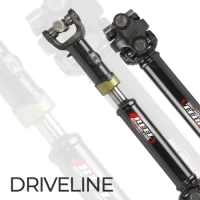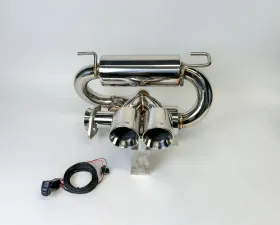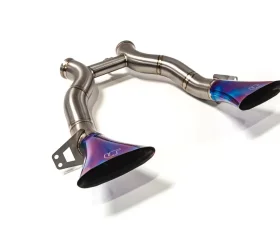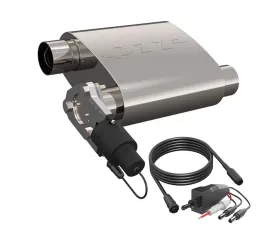Mufflers
Mufflers - Enhance Your Vehicle's Performance with High-Quality Exhaust Solutions from Vivid Racing. Discover a wide selection of premium mufflers at Vivid Racing, designed to improve your vehicle's performance and sound. Our extensive range includes options for various makes and models, ensuring you find the perfect fit for your car. Upgrade your exhaust system today and experience the difference in power and style. Shop now!
Agency Power Valvetronic Exhaust System Black Tips Can-Am Maverick X3 Turbo 2017-2025
Agency Power Valvetronic Exhaust System Polaris RZR XP Turbo | Turbo S
Agency Power Valvetronic Exhaust System Silver Tips Can-Am Maverick X3 Turbo 2017-2025
VRP Titanium Valvetronic Exhaust System Blue Audi R8 Gen 2020+
VRP Valvetronic Exhaust System Black Tips Porsche 991.2 Carrera 3.0T
VRP Valvetronic Exhaust System Polished Tips Porsche 991.2 Carrera 3.0T
VRP Valvetronic Exhaust System Porsche 991 GT3 | GT3 RS 2014-2019
2.50 Inch Reverse Screamer Muffler Short Case with QTEC25 Quick Time Performance
2.50 Inch Reverse Screamer Muffler Standard Case Quick Time Performance
2.50 Inch Screamer Muffler Short Case with QTEC25 Quick Time Performance
2.50 Inch Screamer Muffler Standard Case Quick Time Performance
2007-2018 Jeep Wrangler JK 3.6L/3.8L Screamer Axle Back Black Tips Quick Time Performance
2007-2018 Jeep Wrangler JK 3.6L/3.8L Screamer Exhaust Axle Back Quick Time Performance
2010-2013 Chevrolet Camaro SS 6.2L AR3 Exhaust Axle Back Black Tips Quick Time Performance
2010-2013 Chevrolet Camaro SS 6.2L AR3 Exhaust Axle Back Quick Time Performance
2010-2013 Chevrolet Camaro SS 6.2L Eliminator Exhaust Axle Back Black Tips Quick Time Performance

Why do I Have to Install Mufflers/Resonators?
Suck. Squeeze. Bang. Blow. Repeat.
This is the sort of thing that happens every time you use your car. There are thousands of tiny explosions happening every minute in the combustion chamber. This is happening because the crankshaft spins, the pistons go up and down, and the valves open and shut. And as we all know, movement causes vibration. Which in turn produces noise.
To make sure that a big explosion won’t happen, the exhaust system routes the potentially dangerous exhaust gases away from the combustion chamber. With straighter and larger diameter pipes, the exhaust gases flow faster away from the engine, but it creates a loud racket.
The job of a muffler is to, well, muffle the sound coming out so that you won’t wake up your neighbor at 5 AM on a Saturday morning when you start your performance car. A muffler is specifically made to reduce the noise, sometimes virtually eliminating it.
However, resonators dampen the sound and fine tune the frequencies. All that will be left is a throaty, more polite burble, less noise than a straight pipe yet a more outspoken demeanor compared to mufflers. As automotive enthusiasts, we want resonators in our lives.
What are Resonators?
Resonators are basically just chambers which look like mufflers. However, they are typically quite smaller. They ease out a portion of the noise generated by the engine and they also remove certain frequencies of the exhaust system to provide a better overall sound.
Resonators are typically designed to create a type of sound wave that counteracts a specific sound frequency. The kind of frequency it counters will depend mainly on the car it’s installed on.
How Resonators Work
Car exhaust resonators are generally constructed from hollow steel cylinders. They are built like acoustic resonators which create “exhaust notes” that give off more mellifluous tones. The frequency they create can be improved through the adjustment of exhaust notes.
These accessories are typically add-ons of an exhaust system. They are installed alongside the muffler in the exhaust pipe and work to reduce an otherwise taxing drone.
Exhaust noise will pass through the resonating chamber. And then a resonator alters the sound from a booming drone then countered by the opposing sound waves to produce pleasant pops and crackles.
Reap The Performance Benefits
Although the main function of a resonator is to improve the sound of the exhaust, it also has some performance benefits.
When an exhaust pulse comes through the exhaust system, it creates a low-pressure area behind it. With a good design, this low-pressure area can help pull the exhaust pulses behind it for a better, faster flow. This is known as scavenging. A well-designed resonator will greatly improve scavenging efficiency which leads to much greater flow. And much greater airflow only leads to one thing: More Power!
Resonator Support System
Aside from exhaust resonators, catalytic converters also play an integral role in the overall exhaust cycle. It aids the muffler to complete its job in mitigating exhaust noise.
But instead of cancelling each other’s sound waves, the two work together to limit the sound generated by the exhaust pipe.
Vivid Racing offers everything fromexhaust brackets,catbacks,downpipes,exhaust gaskets,exhaust tips,headers,heat shields,midpipes,mufflers,Y-pipes, and much more.

.jpeg?q=90&p=thumb&w=200&h=200)










.jpeg?q=90&p=thumb&w=40&h=40) Brakes
Brakes  Driveline
Driveline  Electronics
Electronics  Handlebars & Controls
Handlebars & Controls  Package Deals
Package Deals  Wheel Accessories
Wheel Accessories  Wheels by Vehicle
Wheels by Vehicle  Universal & Repair
Universal & Repair  Vivid Racing Gear
Vivid Racing Gear 






















